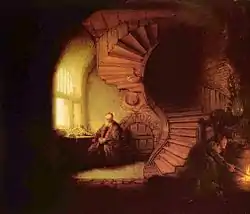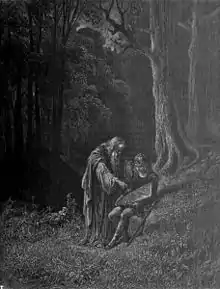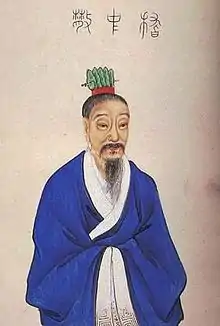Wise old man
The wise old man (also called senex, sage or sophos) is an archetype as described by Carl Jung, as well as a classic literary figure, and may be seen as a stock character.[1] The wise old man can be a profound philosopher distinguished for wisdom and sound judgment.

Traits
This type of character is typically represented as a kind and wise, older father-type figure who uses personal knowledge of people and the world to help tell stories and offer guidance that, in a mystical way, may impress upon his audience a sense of who they are and who they might become, thereby acting as a mentor. He may occasionally appear as an absent-minded professor, appearing absent-minded due to a predilection for contemplative pursuits.
The wise old man is often seen to be in some way "foreign", that is, from a different culture, nation, or occasionally, even a different time, from those he advises. In extreme cases, he may be a liminal being, such as Merlin, who was only half human.
In medieval chivalric romance and modern fantasy literature, he is often presented as a wizard.[2] He can also or instead be featured as a hermit. This character type often explained to the knights or heroes—particularly those searching for the Holy Grail—the significance of their encounters.[3]
In storytelling, the character of the wise old man is commonly killed or in some other way removed for a time, in order to allow the hero to develop on his/her own.
Jungian psychology
In Jungian analytical psychology, senex is the specific term used in association with this archetype.[4] In ancient Rome, the title of Senex (Latin for old man) was only awarded to elderly men with families who had good standing in their village. Examples of the senex archetype in a positive form include the wise old man or wizard. The senex may also appear in a negative form as a devouring father (e.g. Uranus, Cronus) or a doddering fool.
In the individuation process, the archetype of the Wise old man was late to emerge, and seen as an indication of the Self. 'If an individual has wrestled seriously enough and long enough with the anima (or animus) problem...the unconscious again changes its dominant character and appears in a new symbolic form...as a masculine initiator and guardian (an Indian guru), a wise old man, a spirit of nature, and so forth'.[5]
The antithetical archetype, or enantiodromic opposite, of the senex is the Puer Aeternus.
Examples
Historical
- Lao Tzu, author of Tao Te Ching
- Confucius, founder of Confucianism
- Gautama Buddha, founder of Buddhism
- Socrates
- Plato
- Seven Sages of Greece
- Seven Sages of the Bamboo Grove
- Saptarishi
- Navaratnas
- Abraham, Moses, and Solomon in Judeo-Christian tradition
- The Rabbis, or Sages of Talmudic lore (Judaism)
- Yohanan ben Zakkai
- Hillel I
- Shammai
- others
- Jiang Ziya, a genius and patient old man. He was well known as a legendary military strategist and the most famous Prime Minister of the Zhou Dynasty of China.
- Nguyen Binh Khiem, also known as the White Cloud Hermit. He is a saint of the Cao Dai religion and the most prominent person of Vietnam history in the 16th century.
- Ashin Jinarakkhita, also known as Sukong or Grandmaster. He was an Indonesian Buddhist monk who was instrumental in the revival of Buddhism in Indonesia.
- Zarathustra, the Persian avestan sage with a dualist cosmology and theogony in perpetual tension between good and evil.
Mythology

- Mentor (Odyssey), in Greek mythology
- Merlin from the Matter of Britain and the legends of King Arthur
- Nestor from Iliad
- Tiresias from the Odyssey, Oedipus Rex, and other Greek myths
- Utnapishtim from the Epic of Gilgamesh
- Mímir, in Norse mythology
- Chiron from The Iliad
- Odin, in Norse mythology
- Huang Shigong, semi-mythological figure and Taoist hermit who gave the Three Strategies of Huang Shigong to Zhang Liang
Fictional
- Albus Dumbledore, from Harry Potter
- Gandalf, from The Lord of the Rings
- Obi-Wan Kenobi and Yoda, from Star Wars
- Iroh from Avatar: The Last Airbender
- Alfred Pennyworth, from Batman
- Mr. Miyagi, from The Karate Kid
- Master Oogway, from Kung Fu Panda
- Rafiki, from The Lion King
- Master Splinter, from Teenage Mutant Ninja Turtles
- Dungeon Master, from Dungeons & Dragons
Cultural references
In fiction, a wise old man is often presented in the form of a wizard or other magician in medieval chivalric romance and modern fantasy literature and films, in the style of Merlin. Notable examples include Gandalf from The Lord of the Rings and Albus Dumbledore from Harry Potter.
"Senex" is a name of a wise old character in the novel A Wind in the Door by Madeleine L'Engle.
Around the 1850s, the antiquarian Robert Reid used the pseudonym "Senex" when contributing articles on local history in the Glasgow Herald. These were later published in a series of volumes. Sir Alan Lascelles used the pen-name "Senex" when writing to The Times in 1950 setting out the so-called Lascelles Principles concerning the monarch's right to refuse a prime minister's request for a general election.
See also
- Elderly martial arts master
- Hermit
- Ivory Tower
- Jungian psychology
- Magic Negro
- Magicians in fantasy
- Masonic
- Philosopher in Meditation
- Sage (Sophos)
- Wise Old Woman/Man
- Yogi
References
- Northrop Frye, Anatomy of Criticism, p 151, ISBN 0-691-01298-9
- Northrop Frye, Anatomy of Criticism, p 195, ISBN 0-691-01298-9
- Doob, Penelope Reed (1990). The Idea of the Labyrinth: from Classical Antiquity through the Middle Ages. Ithaca: Cornell University Press. pp. 179–181. ISBN 0-8014-8000-0.
- Chalquist, Craig (2007). Terrapsychology: Reengaging the Soul of Place. Spring Journal Books. ISBN 978-1-882670-65-9.
- Franz, Marie-Luise von (1978). "The Process of Individuation". In Jung, C. G. (ed.). Man and his Symbols. London: Picador. pp. 207–208. ISBN 0-330-25321-2.
